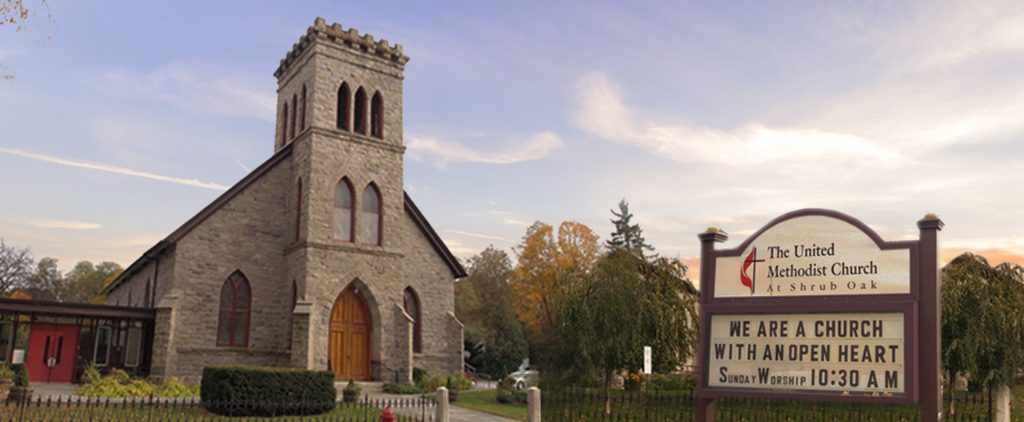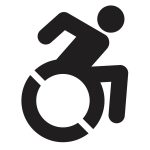The History of the United Methodist Church at Shrub Oak
In commemoration of the 150th Anniversary
of the laying of the current church’s cornerstone in 2017
By Stella Johnson Ganney
The United Methodist Church at Shrub Oak is located in a hamlet in the Town of Yorktown, Westchester County, New York. Its unique history has roots dating back to the 1780s when a French family headed by John Badeau of Mahopac Falls, Putnam County, New York, kindly obliged a traveling Methodist preacher from England (Thomas Ware) to host a special prayer meeting in his home. This was a common practice in the early years of our nation, especially since most ministers returned home to England during the Revolutionary War. The meeting proved very fruitful.
The Badeau Tradition
The Badeau’s were a remarkable family that originally hailed from a long line of French Huguenots but had, for the most part, become practicing Presbyterians once settled in America. Accordingly, the appreciative group that had assembled that night in 1786 quickly agreed to a more formalized schedule of Sunday services with traveling pastors presiding, as established by the Reverend Ware before he moved on to his next stop. (Indeed, the pastor would log a total of 50 years of such service, traveling as an itinerant preacher to places near and far.)
In time, this activity met with a severe backlash from the Presbyterian community that existed around Mahopac Falls. One deacon went so far as to demand the doors be shut to these traveling preachers for fostering “false doctrine.” The public outcry only caused the devoted group to find refuge elsewhere. Eventually, they found sanctuary in the home of Thomas Kirkham of Jefferson Valley, another hamlet of the Town of Yorktown in nearby Westchester County.
The First Church
As the faithful group grew in numbers, larger quarters for worship service were soon needed. Again, one of the Badeau’s (Jacob, John’s grandson) was able to acquire temporary space near Shrub Oak and, shortly after, assisted in the building of a church on East Main Street. At the time of its opening, around 1789, it was named the Methodist Episcopal Church at Stony Street in Yorktown. Designed by local architect William F. Martin, the structure was 50 feet x 90 feet in dimension and it was erected at a cost of approximately $39,000. When it opened, the first United Methodist Church was considered one of the finest churches in the country.
While the first church stood on 1 ¼ acres, an adjacent parcel (3/4 acre) was soon purchased for a cemetery which still exists today. It is interesting to note that Jacob Badeau and Thomas Kirkham, both of whom were instrumental in the development of Methodism in this part of the county, are buried there. (Jacob’s grandfather, John, however, is buried in the old Presbyterian cemetery in Mahopac Falls.) Indeed, both Jacob and Thomas were among the first group of trustees of the first church when the board was formed in 1792.
With the first church still on the New Rochelle Circuit, sort of an agency of traveling pastors, Methodist Bishop Francis Asbury (1745-1816) and the Rev. Freeborn Garretson (1752-1827), two extraordinary “men of the cloth,” were among the first to preside over Sunday service in the “white, wooden structure with green blinds” during its first year of operation. In 1837, a resident preacher, the Rev. Seth Scoffield, was assigned.
As the congregation grew, so did the church, as it expanded its length by another 12 feet during the high point of its history. It wasn’t until 1840, however, when the first church was re-incorporated as the Methodist Episcopal Church of Shrub Oak, reflecting its actual location.
The Present Church
By 1853, the Methodist Society saw it fit to buy a house to be used as a parsonage, as well as six adjacent acres, from congregant Hiram Mabie. The purchase was located across the street from the first church and, in 1867, construction on the new church commenced on the six acres. At this time, the cornerstone “of the new granite edifice” was placed by Bishop Janes, with the assistance of Reverends Dr. Daniel Curry, J.B. Wakely and Henry Ward Beecher, the well-known abolitionist and brother of author Harriet Beecher Stowe (“Uncle Tom’s Cabin”).
As our first church was completed shortly after the American Revolutionary War so, too, was our second church completed shortly after the Civil War. And, on December 13, 1870, the new church was dedicated by Bishop Matthew F. Simpson, a well-respected leader of Methodism who had been a devoted friend and trusted confidante to President Abraham Lincoln before his assassination several years prior.
Shortly after the new church was in operation, a group of local investors bought the old church and moved it to a nearby location, sitting it upon a newly built foundation. After some necessary repairs, they then leased it to various groups for a number of years. One of the tenants included “the Catholics” who were waiting for their own church to be built.
After steady use as a multi-purpose building, the old church nearly fell into ruin. As some of the investors had dropped out of the deal, only two remained. They, in turn, sold it to a single buyer who demolished the old church in 1906 but salvaged most of its wood to “repurpose” into a country cottage on the property.
As for our present day church, although it opened its doors in 1870, it would be well into the 20th Century before it had an organ in place, as well as a series of beautiful stained glass windows, including the Gethsemane window that overlooks the sanctuary – this window in memory of John C. Hart. These were donated by various congregants and crafted by artisan C. D. Rudy of Pennsylvania, a 19th Century painter in oils and designer of ecclesiastical, stained-glass windows.
According to a 1951 newspaper article in the “The Yorktown Herald,” the new church’s interior trim is described as being made of black walnut indigenous to the area. In addition, the stone was hauled by ox and cart from nearby Piano Mountain and the Stony Street Quarry (very much in keeping with today’s eye on green initiatives and sustainable practices). The 1,950-pound bell was forged in a bell factory in Troy, New York, at a cost of $1,000.
Physical Changes
It is clear to see that the new church has gone through various improvements and changes through the years including, but not limited to, two large sheds which protected the horses and carriages that the worshippers used to go church. After the era of automobiles, however, one of the poorly worn sheds was torn down and replaced by tennis courts and additional parking space as a growing number of people were arriving by car. The other shed was repaired with an added cement floor and a summer kitchen installed as used by the Ladies Society of the Church for suppers and fairs.
On January 11, 1948, disaster struck by way of a heavy snow storm and the second shed collapsed. Fortunately, prior to that event, a fund had already been started for the improvement and enlargement of church facilities, as well as additional plumbing and heating repairs. After the second shed collapsed, the Board and various organizations of the church organized and planned the present Parish Hall (70 feet x 30 feet in dimension), a full service kitchen (20 feet x15 feet), a furnace room and other facilities. The actual amount raised for this building was $8,812.09, with all contributions coming from one source or another, as initiated by Rev. Joseph L. Germeck, Episcopal Rector in the Township at the time. In fact, Reverend Germeck had organized a benefit show in the auditorium of a Shrub Oak School, assisted by many of the churches in the township. The proceeds were divided between the Shrub Oak Methodist and Yorktown Presbyterian churches, since the latter had also suffered the same type of loss to the buildings during the same storm.
The present Parish Hall was started around Oct. 7, 1948, and was first used by the Women’s Society of Christian Service for their annual fair in July 1949. A two-story education building was also added in 1966. This, too, evolved into a building that would have many uses.
Most recently, the sanctuary was freshly painted, air conditioning units were installed, windows were repaired and audio visual equipment was updated, making for a refreshing setting in which to worship. Ever a work in progress, UMC at Shrub Oak has other improvements on the drawing board including, but not limited to, repairs to the parking lot, sanctuary floor, wooden doors, bathrooms in the Parish Hall, among others.
UMCSO Today
Today, UMC at Shrub Oak is a vibrant church that can be credited with an excellent Sunday school for approximately 40 children who are often involved in the inner-workings of our church services, from acolytes to liturgists. They also participate regularly in Childrens’ Moments, a special segment of the worship service.
The church also has many young adults who are active in various outreach programs in the community and beyond. For adults, there are several ongoing Bible study programs to suit anyone’s busy schedule. And, for families, there are many church suppers, game nights and other activities that reinforce a Christian lifestyle.
In keeping with the Methodist faith, many times the church’s lifestyle is an interactive one, especially since it participates in several outreach programs including, but not limited to, “Midnight Run” to New York City, a semi-annual effort to help the homeless with clothing, supplies and food; Tres Dias, an international, faith-based organization that reinforces Christian values mostly through periodic religious retreats and other regularly sponsored events; and Operation Christmas Child which distributes Christmas presents to needy children around the world; among others.
On-site programs include Crafts for a Cause, supplies to nearby food pantries, ministry to the afflicted, and more. And, the church also provides a home for Kiddie Kottage, a pre-school day care organization, as well as other community groups.
Through the decades, church membership at UMC at Shrub Oak has maintained a steady base, although one that ebbs and flows. Today, there are approximately 300 members. It has also had dozens of pastors who were assigned for several years at a time. Three pastors, however, stand out in the church’s history as having unusually lengthy pastorships and these include the Rev. Russell Dorsett for 16 years, the Rev. James Davis for 21 years and the Rev. Jacob Dharmaraj for 14 years.
While our church music often relies on the traditional hymns of our church hymnals, recently it has expanded its offerings to include live music and Contemporary Christian selections on occasion.
New Leadership
Recently, the church welcomed a new leader, Pastor Iwy Patel-Yatri, who joined UMC at Shrub Oak in 2015. She is not only our first full-time female pastor, but the first to fully utilize technology and social media to foster and promote our church in the community as we approach 2017, the 150th Anniversary of the laying of our current church’s cornerstone in 1867. May God bless “Pastor Iwy” and her family in performing the Lord’s work and administering the future plans that He has set forth for our growing congregation and vital community church.
The United Methodist Church
Our story is not complete until it is placed in the context of the history of the greater Methodist movement around the world. Visit the History page of The United Methodist Church for a broader view of who we are and where we came from.

